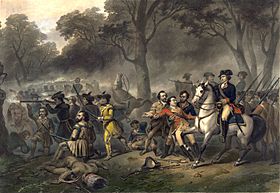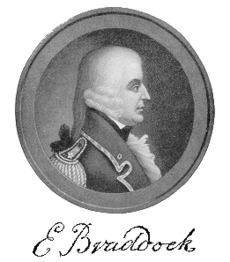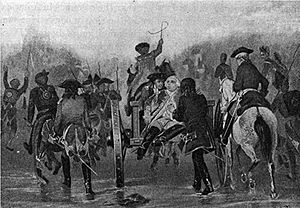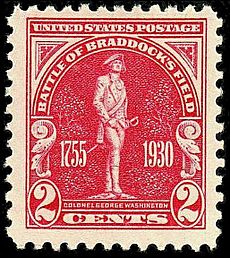Battle of the Monongahela facts for kids
Quick facts for kids Battle of the Monongahela |
|||||||
|---|---|---|---|---|---|---|---|
| Part of the French and Indian War | |||||||
 Washington the Soldier Lt. Col. Washington on horseback during the Battle of the Monongahela — Reǵnier 1834 |
|||||||
|
|||||||
| Belligerents | |||||||
Ottawas Ojibwa Potawatomis |
|||||||
| Commanders and leaders | |||||||
|
|
|||||||
| Strength | |||||||
| 637 First Nations (the Ottawas, Ojibwa and Potawatomis) 108 troupes de la Marine 146 militia Total: 891 |
1,300 regulars and provincial troops. | ||||||
| Casualties and losses | |||||||
| 39 killed 57 wounded |
457 killed 450+ wounded |
||||||
The Battle of the Monongahela was a major fight during the French and Indian War. It happened on July 9, 1755, near what is now Braddock, Pennsylvania. A British army, led by General Edward Braddock, was trying to capture Fort Duquesne. However, they were defeated by French and Canadian soldiers, along with their Native American allies.
This battle ended the Braddock Expedition. The British had hoped to take Fort Duquesne and control the important Ohio Country. Both General Braddock and the French commander, Captain Daniel Liénard de Beaujeu, died during the battle. Braddock was badly wounded and passed away during the retreat. He asked George Washington, who was with him, to make sure he was buried properly. The British army had to retreat, and the French kept control of the fort and the area until 1758.
The Native American allies of the French were very good at fighting in the forests. They used the land to their advantage, causing many British soldiers to be hurt or killed. The French and their allies surprised the British, which helped them win this important battle.
Contents
Background to the Battle
General Braddock was sent to North America as the new Commander-in-Chief. He brought two regiments of soldiers from Ireland. He also recruited local troops in British America, making his force about 2,200 men. They started their march from Fort Cumberland, Maryland, on May 29. George Washington, a colonel from Virginia, joined him. Washington had led an earlier trip to this area.
Braddock's trip was part of a bigger plan to attack the French in North America. His orders were to attack the Ohio Country, an area both Britain and France wanted. The French controlled this area from Fort Duquesne, located where the Ohio River forks. After taking the fort, Braddock was supposed to move on to Fort Niagara. This would give Britain control over the Ohio territory.
Braddock faced several problems early on. He didn't think he needed many local Native Americans as scouts. So, he only had eight Mingo guides. The road they were using was very slow. It needed constant widening to move their cannons and supply wagons. Because of this, he split his army into two groups. He led a faster group ahead, while a slower group followed with the heavy equipment.
The Battle Begins
On July 9, the faster group of 1,300 soldiers crossed the Monongahela River. They were only about 10 kilometers (6 miles) from Fort Duquesne. Even though they were tired from weeks of tough travel, many British and American soldiers expected an easy win. Some even thought the French would just leave the fort when they arrived.
Fort Duquesne had not been strongly defended. But it had recently received many more soldiers. Claude-Pierre Pecaudy de Contrecœur, the Canadian commander of the fort, had about 1,600 French soldiers, Canadian militia, and Native American allies. Worried about the British approach, he sent Captain Daniel Liénard de Beaujeu with about 800 troops. This group included French soldiers, Canadian militia, and 600 Native American warriors. Their mission was to stop the British advance.
The French and Native American forces arrived too late to set up a full ambush. They had been delayed, and the British had moved faster than expected. They ran into the British advance guard, led by Lieutenant Colonel Thomas Gage. When Gage saw the enemy in the trees, he ordered his men to fire. Even from a long distance for their muskets, their first shots killed Captain Beaujeu.
Fighting in the Forest
The Native American warriors were not worried by Beaujeu's death. They quickly took up positions to attack. They were fighting on land they knew well, with many trees and bushes separated by open areas. The British soldiers' first shots caused about 100 French soldiers to run back to the fort. But Captain Dumas gathered the remaining French troops. The Native American tribes allied with the French, including the Ottawas, Ojibwa, and Potawatomis, used frightening tactics against the British. They made loud "whoop" sounds that caused fear and panic among the British soldiers.
As they faced heavy fire, Gage's advance guard started losing soldiers and pulled back. In the narrow road, they crashed into the main part of Braddock's army. Braddock's main force had moved quickly when they heard the shots. Even though they had more soldiers, the British were immediately on the defensive. Most of the regular soldiers were not used to fighting in forests. They were terrified by the deadly musket fire coming from hidden enemies. There was a lot of confusion, and some British groups even fired at each other.
The entire British column fell into disorder. The Canadian militia and Native Americans surrounded them. They kept firing at the British from the woods on both sides of the road. At this time, the French regular soldiers began to move forward on the road, pushing the British back. General Braddock rode forward to try and get his men back in order. But they had lost all sense of teamwork.
Following Braddock's lead, the officers tried to get their units back into formation on the narrow road. This didn't work well. It just made them easier targets for the hidden enemy. Cannons were used, but they were not effective in the dense forest. Braddock had several horses shot from under him. Still, he remained calm, which was the only sign of order for the scared British soldiers. Many American soldiers, who were not trained like the British regulars to stand their ground, ran and hid behind trees. The British soldiers, wearing red coats, sometimes mistook them for enemies and fired at them. The rear guard, made up of Virginians, fought well from behind trees. They had learned this way of fighting from years of fighting Native Americans.
Despite the difficult conditions, the British tried to stand firm and fire at the enemy. Braddock believed the enemy would eventually give up against the discipline of his English-led troops. Even without officers to lead them, the groups of soldiers tried to hold their lines.
British Retreat
Finally, after three hours of intense fighting, Braddock was shot in the lung. He fell from his horse, badly wounded. His men carried him to safety. Because Braddock was wounded, and without a clear order, the British began to retreat. They mostly did so in an orderly way until they reached the Monongahela River. There, the Native American warriors attacked them. The Native Americans attacked with hatchets and knives. Panic spread among the British troops. They broke ranks and ran, thinking they would all be killed.
Colonel Washington, even though he didn't have an official command role, managed to bring some order. He formed a rear guard, which helped the remaining soldiers escape. By sunset, the surviving British forces were running back down the road they had built. Behind them, bodies were piled high on the road. The Native Americans did not chase the fleeing British soldiers. Instead, they took supplies from the wounded and dead.
Some British soldiers and women were captured in the battle. Some soldiers were spared, as were most of the women. However, about a dozen soldiers were killed by the Native Americans that night. This was seen by a British prisoner named James Smith.
Daniel Boone, a famous American explorer and woodsman, was among the soldiers in the battle. Boone worked as a wagon driver. He narrowly escaped death when Native American troops attacked the baggage wagons. Boone is said to have escaped by cutting his wagons loose and fleeing. He often criticized Braddock's mistakes for the rest of his life. During this trip, Boone met John Finley, who told him about the many animals and natural wonders of the Ohio Valley. Finley later took Boone on his first hunting trip to Kentucky.
Aftermath of the Battle
Out of about 1,300 men Braddock led into battle, 456 were killed and 422 were wounded. Officers were often targeted and suffered greatly: 26 out of 86 officers were killed, and 37 were wounded. Of the about 50 women who came with the British army as maids and cooks, only 4 returned with the British. About half were taken prisoner. The French and Canadians reported only 23 killed, including their commander, and 20 wounded.
Braddock died from his wounds on July 13, four days after the battle. He was buried on the road near Fort Necessity.
Colonel Thomas Dunbar took command of the British forces. He was with the reserve and supply units. He realized his army could not capture Fort Duquesne. So, he decided to retreat. He ordered the destruction of supplies and cannons, burning about 150 wagons. His forces then retreated back toward Philadelphia. The French did not chase them, as they didn't have enough resources for a long pursuit.
Captain Daniel Liénard de Beaujeu, the French commander, was buried on July 12 at Fort Duquesne.
This battle was a terrible defeat for the British. It showed how difficult it would be to defeat the French and their Native American allies in North America. The British learned from their mistakes. Later in the French and Indian War and the American War of Independence, they made better use of soldiers who could fight in a less organized way, like skirmishers. These soldiers could protect the main army from hidden attacks.
The battle is often mistakenly called an ambush. But the French were actually surprised when they met the British. However, their quick reaction allowed them to gain the upper hand and win the battle.
The French remained strong in the Ohio Country for the next three years. They convinced many Native American tribes, who had been neutral, to join them in the war. The French were finally forced to leave Fort Duquesne in 1758 when the Forbes Expedition approached.
Legacy
In 1930, on the 175th anniversary of the Battle of Braddock's Field, a statue of Colonel Washington was revealed. A special postage stamp, based on that statue, was released on the same day.




